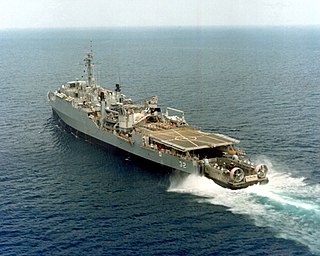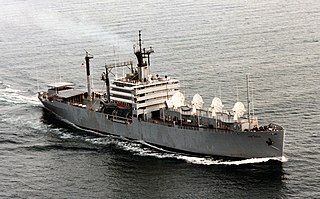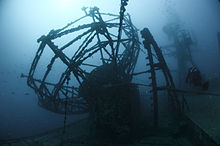
USS Denver (LPD-9), an Austin-class amphibious transport dock, was the third ship of United States Navy to bear this name. Denver's keel was laid on 7 July 1964 at Lockheed Shipbuilding and Construction Company, Seattle, Washington. She was launched on 23 January 1965, christened by Mrs. Ann Daniels Love, wife of John A. Love, the former governor of Colorado, and commissioned on 26 October 1968. After 46 years of service, Denver was decommissioned at Joint Base Pearl Harbor–Hickam on 14 August 2014. At the time of her decommissioning, Denver was the oldest deployable warship in the U.S. Navy, and was one of the last active warships to have served in Vietnam.

USS Spiegel Grove (LSD-32) was a Thomaston-class dock landing ship of the United States Navy. She was named for Spiegel Grove, the home and estate in Fremont, Ohio, of Rutherford B. Hayes, the 19th President of the United States.

USNS Observation Island (T-AGM-23) was built as the Mariner-class merchant ship Empire State Mariner for the United States Maritime Commission, launched 15 August 1953, and operated by United States Lines upon delivery on 24 February 1954, making voyages for the Military Sea Transportation Service (MSTS) until going into reserve at Mobile, Alabama on 9 November 1954.

A tracking ship, also called a missile range instrumentation ship or range ship, is a ship equipped with antennas and electronics to support the launching and tracking of missiles and rockets. Since many missile ranges launch over ocean areas for safety reasons, range ships are used to extend the range of shore-based tracking facilities.

USS Muliphen (AKA-61/LKA-61) was an Andromeda-class attack cargo ship in service with the United States Navy from 1944 to 1970. She was sunk as an artificial reef in 1989.

USAS American Mariner was a United States Army research vessel from January 1959 to 30 September 1963. She was originally assigned to the DAMP Project by the Advanced Research Projects Agency (ARPA) to attempt to collect radar signature data on incoming intercontinental ballistic missiles in the Caribbean, the South Atlantic Ocean, and the Indian Ocean. Her initial operations involved providing radar track on the Atlas missile, which was under development at the time. Subsequently, she provided track on other types of missiles as they proceeded through their development and operational stages. In September 1963 the original contract was transferred to the USAF until the completion of the testing phase in 1964.

USS Kittiwake (ASR-13) was a United States Navy Chanticleer-class submarine rescue vessel in commission from 1946 to 1994.

The General G. O. Squier class of transport ships was built for the U.S. Navy during World War II. The class was based upon the Maritime Commission's Type C4 ship. The class was named for United States Army Major General George Owen Squier.

USNS General H. H. Arnold (T-AGM-9) was a General G. O. Squier-class transport ship for the U.S. Navy in World War II. She was named in honor of U.S. Army general Robert Emmet Callan. She was transferred to the U.S. Army as USAT General R. E. Callan in 1946. On 28 April 1950 she was transferred to the Military Sea Transportation Service (MSTS) as USNS General R. E. Callan (T-AP-139). Placed in reserve in 1958, she was transferred to the U.S. Air Force in 1961 and renamed USAFS General H. H. Arnold in 1963, in honor of Henry H. Arnold, the first and only General of the Air Force. She was reacquired by the Navy in 1964 as USNS General H. H. Arnold (T-AGM-9). She was struck from the Naval Vessel Register on 1 March 1982.

The Type C4-class ship were the largest cargo ships built by the United States Maritime Commission (MARCOM) during World War II. The design was originally developed for the American-Hawaiian Lines in 1941, but in late 1941 the plans were taken over by the MARCOM.

USNS Range Recoverer (T-AG-161/T-AGM-2/YFRT-524) was a missile range instrumentation ship responsible for providing radar and/or telemetry track data on missiles launched from American launch sites.

USNS Sword Knot (T-AGM-13) was a missile range instrumentation ship which operated as USAFS Sword Knot on the United States Air Force's Eastern Range during the late 1950s and early 1960s. Sword Knot operated under an Air Force contract with Pan American Airways Guided Missile Range Division headquartered in Cocoa Beach, Florida.

SS Benwood was a steam cargo ship of the early twentieth century. Built by Craig, Taylor & Co Ltd., Stockton on Tees, she entered service with Joseph Hoult & Co. Ltd, Liverpool. She passed through several owners, before being lost in a collision off the coast of Key Largo, Florida in 1942. Her wreck is now a popular dive site.
The following index is provided as an overview of and topical guide to Wikipedia's articles on recreational dive sites. The level of coverage may vary:

Recreational dive sites are specific places that recreational scuba divers go to enjoy the underwater environment or for training purposes. They include technical diving sites beyond the range generally accepted for recreational diving. In this context all diving done for recreational purposes is included. Professional diving tends to be done where the job is, and with the exception of diver training and leading groups of recreational divers, does not generally occur at specific sites chosen for their easy access, pleasant conditions or interesting features.

The James River Reserve Fleet (JRRF) is located on the James River in the U.S. state of Virginia at near Fort Eustis. James River Reserve Fleet, a "ghost fleet", is part of the National Defense Reserve Fleet. The Reserve Fleet ships in storage, called "mothballed", that can be ready for use if needed. Many are awaiting scrapping due to the age or condition of the ship. Some ships are used for target practice or as artificial reefs. A few ships became museum ships and other sold to private companies. Ships can be readied for use in 20 to 120 days during national emergencies or natural disaster. The U.S. Department of Transportation's Maritime Administration (MARAD) provides oversight of the James River Reserve Fleet. For the United States Navy ships the United States Navy reserve fleets stored these ships and submarines.


















